Click on images to enlarge
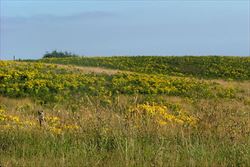
large infestation (Photo: Sheldon Navie)
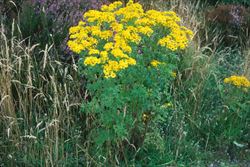
habit (Photo: Steve Adkins)
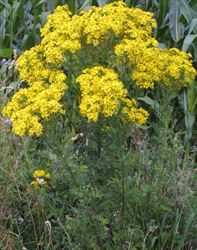
habit (Photo: Trevor James)

elongated and deeply-divided lower leaf (Photo: Trevor James)
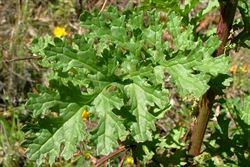
stem and upper leaf (Photo: Sheldon Navie)
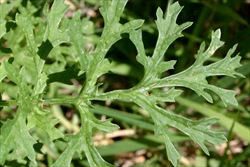
close-up of deeply-divided upper leaf (Photo: Trevor James)

cluster of numerous flower-heads (Photo: Sheldon Navie)

close-up of young flower-heads (Photo: Trevor James)
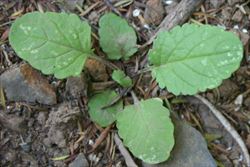
seedling (Photo: Trevor James)

young plants (Photo: Trevor James)
Scientific Name
Senecio jacobaea L.
Synonyms
Jacobaea vulgaris Gaertn.
Family
Asteraceae (Queensland, New South Wales, the ACT, Victoria, Tasmania, Western Australia and the Northern Territory)Compositae (South Australia)
Common Names
common ragwort, hysterical weed, ragwort, stagger wort, staggerwort, tansy butterweed, tansy ragwort, stinking willie, stinking willy, St James' wort, yellow ragwort
Origin
Native to north-western Africa (i.e. Algeria, Morocco and Tunisia), Europe and western and central Asia (i.e. Lebanon, Syria, Armenia, Azerbaijan, Georgia, Russia, Kazakhstan, Tajikistan, Uzbekistan and Mongolia).
Naturalised Distribution
Widely naturalised in southern Australia (i.e. on the southern and central tablelands regions of New South Wales, in Victoria and Tasmania, in south-eastern South Australia and in south-western Western Australia).
Habitat
A weed of pastures, open woodlands, disturbed sites, waterways, swamps, lake margins, and sometimes also crops, in wetter temperate regions.
Habit
An upright (i.e. erect) and relatively long-lived (i.e. biennial or perennial) herbaceous plant usually growing 45-120 cm tall, but occasionally reaching up to 1.8 m in height. This species forms a basal rosette of leaves during the early stages of growth.
Distinguishing Features
- an upright and long-lived herbaceous plant that forms a basal rosette of leaves during the early stages of growth.
- it later produces one or more upright stems that are much-branched towards the top of the plant.
- its deeply-divided leaves are dark green and mostly hairless above, and somewhat paler and hairy underneath.
- its bright yellow flower-heads (20-25 mm across) are borne in dense clusters at the tops of the branches and have 12-15 elongated 'petals'.
- the bases of the flower-heads are surrounded by about thirteen small greenish bracts that have black or brown tips.
- it gives off an unpleasant smell when damaged.
Stems and Leaves
One or more upright (i.e. erect) stems arise from a long-lived (i.e. biennial or perennial) rootstock. These stems are much-branched towards the top of the plant and are ribbed or furrowed. They may be initially sparsely covered in cobweb-like hairs and are often reddish or purplish in colour towards the base of the plant.
All leaves are dark green and hairless (i.e. glabrous) above and somewhat paler underneath (i.e. discolorous) with a covering of downy or cobwebby hairs (i.e. pubescent). Rosette leaves are relatively large (up to 35 cm long), with distinct stalk-like (i.e. petiolate) bases (10-30 mm long) and deeply divided margins. Stem (i.e. cauline) leaves are smaller (up to 15 cm long) and often stalkless (i.e. sessile) or stem-clasping.
Flowers and Fruit
The bright yellow flower-heads (i.e. capitula) are borne in dense clusters at the tops of the branches. These flower-heads (20-25 mm across) have several (12-15) elongated 'petals' (i.e. ray florets) that are 6-10 mm long and about 1 mm wide. They also have numerous small 'disc' or 'tubular' florets in the centre and are surrounded by several (about 13) small greenish bracts (5-6 mm long) that have black or brown coloured tips. Flowering occurs during summer and early autumn.
The seeds (i.e. achenes) are brown in colour (1-3 mm long) and topped (at least initially) with a ring (i.e. pappus) of fine whitish hairs (4-6 mm long). Some of the seeds (those produced by the ray florets) are smooth in texture and hairless (i.e. glabrous), while the majority (those produced by the tubular florets) are covered in fine hairs or bristles.
Reproduction and Dispersal
Reproduction occurs via seed and from pieces of the long-lived crowns.
Most dispersal of this species is thought to be a result of seeds being spread by wind, water, animals, vehicles, humans and in contaminated agricultural produce. Spread may also occur when root and crown segments are broken off and moved to new areas by cultivation equipment and other machinery.
Environmental Impact
Ragwort (Senecio jacobaea) is regarded as an environmental weed in Victoria and Tasmania, and was recently listed as a priority environmental weed in three Natural Resource Management regions.
Legislation
This species is declared under legislation in the following states and territories:
- New South Wales: Class 4 - a locally controlled weed. The growth and spread of this species must be controlled according to the measures specified in a management plan published by the local control authority and the plant may not be sold, propagated or knowingly distributed (in the Gundagai, Tumbarumba and Tumut local authority areas).
- South Australia: 1@ - this species is declared under Class 1c(i), a classification for prohibited terrestrial plants. Its presence must be notified and the plant must be destroyed (throughout the entire state).
- Tasmania: D - the importation or sale of this species is prohibited and measures to reduce its population in an area, eradicate it from an area, or restrict it to a particular area may be required.
- Victoria: P1 - prohibited and must be eradicated or controlled (in the Goulburn region only), and C6 - all reasonable steps must be taken to control the weed and prevent its spread (in the Glenelg, Corangamite, Port Phillip West, Port Phillip East, West Gippsland and East Gippsland regions).
- Western Australia: P1 - trade, sale or movement into the state prevented, and P2 - to be eradicated where found (throughout the entire state).
Management
For information on the management of this species see the following resources:
- the Victorian Department of Sustainability and Environment Landcare Note on this species, which is available online at http://www.dse.vic.gov.au.
- the Tasmanian Department of Primary Industries and Water weed service sheet on this species, which is available online at http://www.dpiw.tas.gov.au.
- the Western Australian Department of Agriculture and Food information page on this species, online at http://www.agric.wa.gov.au.
Similar Species
Ragwort (Senecio jacobaea ) is similar to several introduced species including common groundsel (Senecio vulgaris), fireweed (Senecio madagascariensis) and African daisy (Senecio pterophorus). These species can be differentiated by the following differences:
- ragwort (Senecio jacobaea) is a relatively tall and long-lived (i.e. biennial or perennial) plant (30-150 cm tall). It has deeply divided leaves (i.e. lyrate-pinnatifid or bi-pinnatisect) with irregularly toothed margins. These leaves have hairless (i.e. glabrous) upper surfaces and hairy or cobwebby lower surfaces, and they appear to have a stalk at the base (i.e. the base is petiole-like). Its flower-heads (i.e. capitula) have obvious 'petals' (i.e. ray florets), are usually enclosed in about 13 bracts (i.e. involucral bracts), and are usually borne in large, relatively dense, clusters.
- common groundsel (Senecio vulgaris) is a low-growing and short-lived (i.e. annual) plant (10-50 cm tall). It has deeply divided leaves (i.e. pinnatifid) with irregularly toothed margins. These leaves have hairless (i.e. glabrous) upper surfaces and sparsely hairy or hairless (i.e. glabrous) lower surfaces, and they appear to have a stalk at the base (i.e. the base is petiole-like). Its flower-heads (i.e. capitula) do not have obvious 'petals' (i.e. ray florets), are usually enclosed in 18-23 bracts (i.e. involucral bracts), and are usually borne in small, relatively loose, clusters.
- fireweed (Senecio madagascariensis) is a low-growing and short-lived (i.e. annual or biennial) plant (20-60 cm tall). It has elongated (i.e. lanceolate), or sometimes lobed, leaves with toothed or occasionally entire margins. These leaves have mostly hairless (i.e. glabrous) upper and lower surfaces and they are stem-clasping (i.e. sessile). Its flower-heads (i.e. capitula) have obvious 'petals' (i.e. ray florets), are usually enclosed in 19-21 bracts (i.e. involucral bracts), and are borne in loose clusters (containing 2-10 heads).
- African daisy (Senecio pterophorus) is a tall and long-lived (i.e. perennial) plant (80-150 cm tall). It has elongated (i.e. lanceolate) leaves with toothed or occasionally entire margins. These leaves have mostly hairless (i.e. glabrous) upper surfaces and whitish or cobwebby lower surfaces. They have a narrow stalk-like base (i.e. the base is petiole-like) and the stems are winged. Its flower-heads (i.e. capitula) have obvious 'petals' (i.e. ray florets), are usually enclosed in 18-22 bracts (i.e. involucral bracts), and are borne in large spreading clusters.
Ragwort (Senecio jacobaea) is also similar to several native Senecio species, which cannot all be mentioned here.

